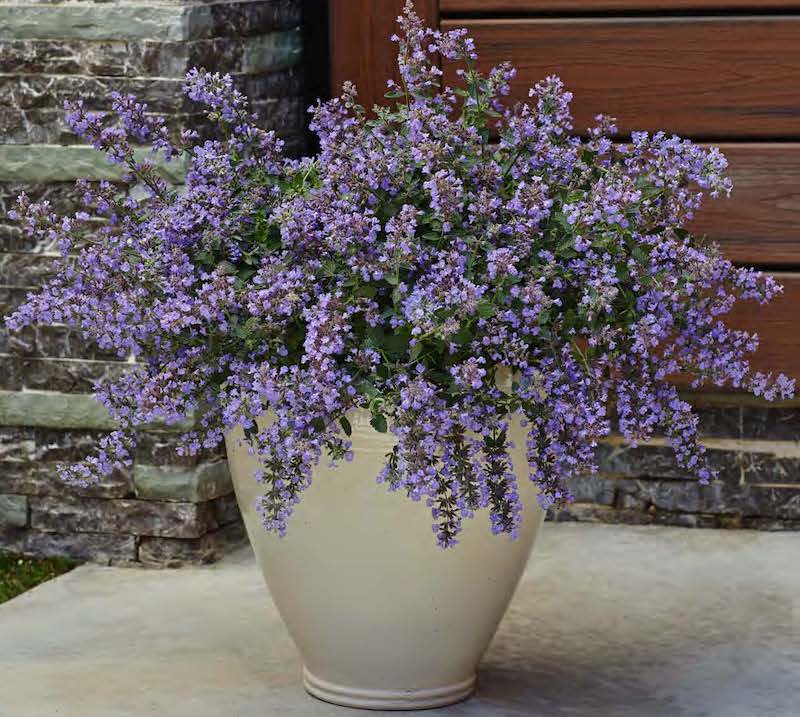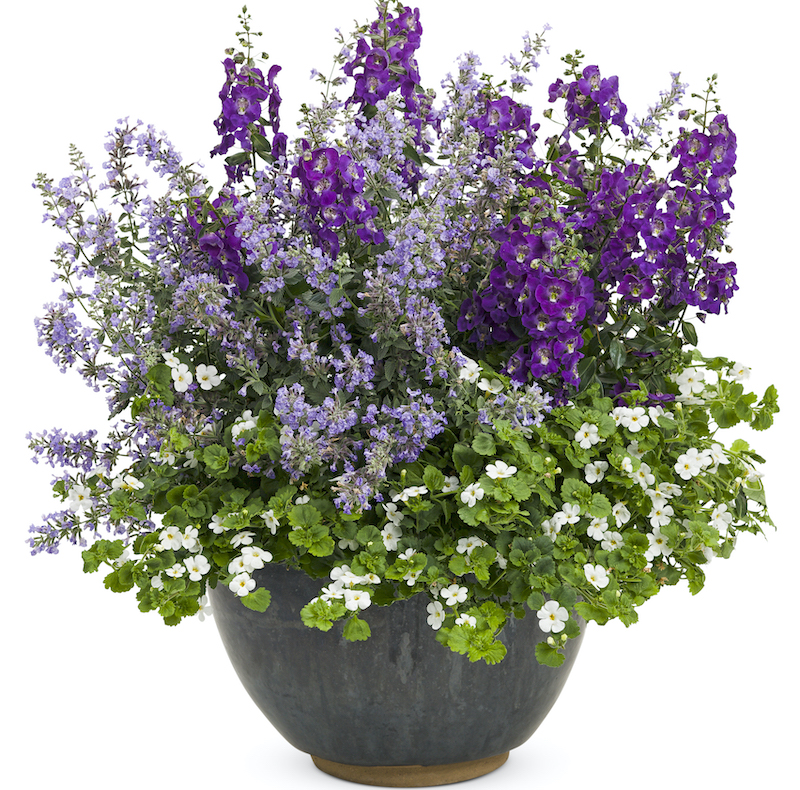Catmint can be grown successfully in containers for the patio or deck, and with just a few extra considerations, will thrive for a long time. There are over 250 varieties of ornamental Catmint to choose from. The smaller-sized plants will be at-home in pots that are 5 gallons (12 inch diameter) or larger. The smallest-sized Catmint would look great planted with a few heat-loving annuals, such as Verbena, Lantana, or Sweet Potato vine. Using fall- or spring-blooming annuals is also a great way to give the container year-round interest when the Catmint is dormant.

Planting Catmint in Pots
Catmint can be planted in containers almost any time of the year. Planting in the spring, as the Catmint starts growing, is the optimal time. Place the container in a spot that will get all-day sun, or shade only very early or very late in the day. Pots with a 12-inch diameter or greater will have enough space for Catmint to establish a healthy root system. Any pot used needs to have excellent drainage so that Catmint is not sitting in water-logged soil for a period of time. Pots made from composite resin or plastic will last longer, especially in the colder hardiness zones that have a lot of freezing and thawing through the winter. If the container needs better drainage, holes can be drilled in the bottom of a plastic or resin pot quite easily.

Best Soil For Catmint in Pots
All-purpose potting soil is the right choice for growing Catmint. It is typically mixed with perlite or vermiculite to make the soil moisture retentive, light, and well drained. The potting soil can have added fertilizer or fertilizers can be added separately. In the past, pebbles or rocks at the bottom of the container were recommended to aid drainage of the pot. However, rocks actually form a perched water table, making the bottom of the soil hold too much water instead of draining. Filling the whole pot with potting soil will avoid this problem and keep the plant's roots healthy.
A final layer of mulch on the top of the pot will have the same benefits as mulching plants in a garden bed: keeps the soil cool, retains moisture longer, and suppresses weeds. Using more decorative mulches, such as colored glass, river pebbles or marble chips, in containers also can add a polished look to a patio or deck setting.
Caring For Catmint in Planters
Container-grown plants rely completely on the gardener for any water, food, and protection from harsh winter weather. Pots insulate the plant's roots much less than a planting in the ground. Cold winters will feel colder to plants and hot summers can be scorchers.
Watering Catmint in Pots
Watering a plant in a container is crucial for it to thrive. The potting soil needs consistent moisture, while remaining free draining. Early in the spring, watering may not have to be done every day. When the top 2 inches of soil is dry, it is time to give the container a thorough watering. During periods of heat and drought, containers will need to be checked every day. As a rule, smaller pots dry out much faster than larger planters. Always water until there is runoff coming out of the bottom. This will ensure that the soil is evenly wet throughout the pot.
Fertilizing Catmint in Pots
Catmint will need regular feeding throughout the growing season. The easiest fertilizer to use is a diluted liquid feed that is well balanced. If Catmint is planted with other plants, make sure to use an all-purpose fertilizer. Once a month is generally sufficient for fertilizing Catmint. Any extra fertilizer that the plant does not use will be leached out of the soil by regular watering. Always follow the manufacturer's recommendation for application amounts.
Winter Care For Catmint in Pots
Pots that are left outside through the winter need to be durable enough to withstand freeze-thaw cycles. Terracotta and glazed ceramic pots are typically more delicate and need to either be taken in during the winter or only used in the warmer hardiness zones. Composite resin and plastic pots are exceptionally durable and even can have the good looks of terracotta or ceramic. Catmint will not need much for extra protection in a container. The plant is dormant the whole winter and completely dies back.
The main consideration will be to make sure the pot is not in an area that will get too much water or be standing in a seasonally flooded area. Moving pots to a sheltered position or putting the container on top of bricks or ‘pot feet’ helps to keep the plant from getting waterlogged. Catmint is a hardy perennial that will be much happier staying outside through the winter. It needs a period of cold to complete its dormancy cycle.
Growing Catmint Indoors
Catmint needs periods of cold dormancy to remain a vigorous grower. There is no need to bring potted Catmint into a garage or unheated greenhouse for the winter. It does not make an attractive houseplant and requires more light than most windows can provide.
 |
Author Robbin Small - Published 7-14-2022 |
